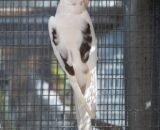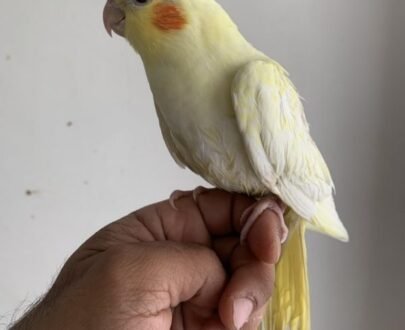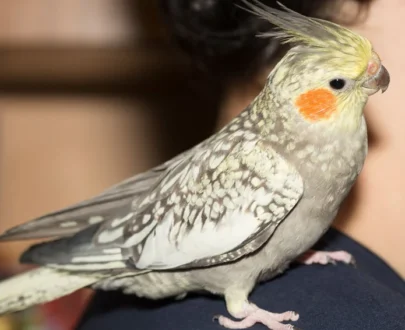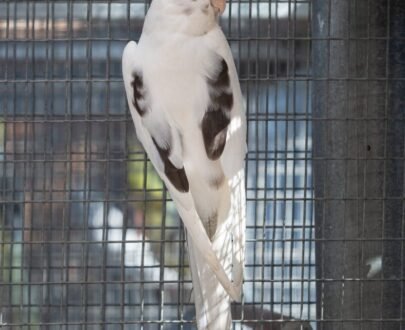- You have no items in your shopping cart
- Subtotal: $0.00
Everything You Need To Know About the Cockatiel Grey White Face
If you’re looking for a somewhat unique and striking small pet birds, the white-faced cockatiel fits the bill. Genetically, this bird is a color mutation with a white or grayish colored face. The result stands out, as there are no orange cheek patches or yellow colorings. As anyone familiar with cockatiels knows, this is quite a departure from what you would typically see in these beautiful birds.
Their striking appearance, uniqueness, and intelligence make them very desirable birds.
Whether you’re thinking of adopting a white-faced cockatiel or different types of birds, or you merely want to learn more about them, here’s what you need to know about these magnificent birds!
White-Faced Cockatiel Breed Information

The white-faced cockatiel has a unique appearance. As noted above, these birds have a white or grayish face. There are no traces of orange or yellow. As you might expect, they have gray plumage. This cockatiel is not a bird with orange cheeks!
Some people mistakenly believe that these beautiful birds are a variant of albino cockatiel birds. However, this isn’t entirely accurate. Albino cockatiels are a little misnamed. They often have a white appearance. Yet, they also frequently have yellow plumage. The fact that the albino cockatiels have some color makes the white-faced cockatiels more gray or white than the albino ones.
These birds live quite a long time. In captivity, they can live for around 20 years. In the wild, with predators and other problems that they might encounter, their lifespan is quite a bit less. If you want to improve your pet bird’s longevity, check out these tips on how to increase your bird’s lifespan.
Environment And Feeding For White Cockatiels
White faced cockatiels are not particularly hard in terms of care, making them an ideal first pet bird.
All cockatiels require a decent sized cage to be happy. At a minimum, the cage you buy for your white-faced cockatiel should be at least two feet cubed. In other words, the cage should be two feet long, two feet wide, and two feet tall. Anything smaller than that and your whiteface cockatiel will begin to feel crowded. However, sale parrot if you have the room to get a larger cage in your home, you should go ahead and do it. The more space, the better off your pet will be!
In terms of food, you should feed your cockatiel, specially formulated cockatiel food. There are a couple of brands, Harrison’s and Zupreem, that you might want to consider. Like other birds, these white face cockatiel for sale have specific dietary needs. Most of their nutrition should come from pellets.
However, we all know how much fun feeding these birds treats can be! While they should be sparing, treats are an excellent way for you and your bird to bond. You may wish to give your bird fruits such as pears, orange, pomegranate, apple, or banana. These birds also like vegetables such as carrots, cooked sweet potatoes, peas, or celery. Baby birds also have a different diet so keep that in mind.
White-Faced Cockatiel Health Signs And Symptoms

No matter if you’re an experienced bird owner or someone new to having cockatiels, you’ll want to make sure that your pet is healthy. The best way to do that is to provide your cockatiel with high-quality pet food, lots of exercise time, and plenty of socialization. Cockatiels, like many other birds, are very social creatures. They can become lonely and depressed relatively quickly.
It’s also worth noting that any genetic cockatiel mutation (meaning the ones that aren’t birds with orange cheeks, like the white-faced Cockatiel) generally has a less-developed immune system. Since these color variants are mutations, they can (not always!) have some slight deficiencies in overall health and immunity.
In particular, if you have one of these birds, you should look out for:
- Bacterial threats: In particular, a bacteria strain called Chlamydophila psittaci can cause respiratory distress in cockatiels. What makes this bacteria even scarier is that cockatiels often show no signs of respiratory distress. Therefore, your bird could be sick, and you could potentially not know until things were much more severe.
- Yeast infections: These gastrointestinal infections cause many problems in cockatiels (none life-threatening, though). However, if your bird has one of these, expect them to have runny stools and potentially regurgitation. The fact that their tummy won’t feel well means that they’re likely to lose weight and have a loss of appetite.
- Giardia: Some cockatiels can get this parasite. If you see your cockatiel with diarrhea and lots of itching, your bird might have this problematic parasite.
Of course, much like humans, cockatiels can also suffer from obesity and lack of exercise. Without adequate socialization, they may feel depressed.
These Birds Make Amazing Pets!
White-faced cockatiels make lovely pets. They’re intelligent, striking in appearance, and they are generally healthy. Make sure to feed them well, have a vet close by if you see any signs of illness, and give them plenty of exercise space and time.
If you are planning on getting one of these birds, please note that they are reasonably rare. You’ll likely only find them through a breeder. While prices may vary throughout the country, most people should expect to pay somewhere between $200 and $300 for one of these birds. Never pay more than $500 (since that’s likely a rip-off) and never pay less than $100 or so. A bird that cheap likely has problems.
Are white-faced cockatiels rare?
These birds used to be significantly rarer than they are now. Nowadays, you can find breeders that will specialize in white-faced cockatiels. You likely won’t find them through other sources, however.
How long do white-faced cockatiels live?
The lifespan of a white-faced cockatiel ranges from 16 to 25 years, on average. Of course, cockatiels kept in the best of conditions have the highest likelihood of living the longest. Ensure you have access to quality medical care, proper living conditions, and frequently engage with your bird!
How can you tell the gender of a cockatiel?
Males and females have a few different characteristics. Females tend to be more reserved and more likely to hiss and bite. Males tend to be more boisterous. Females tend to have colorings on the tail feathers’ underside, while males have darker colors over their bodies.
Baby Cockatiel Available! Cockatiels are wonderful companions. They make fantastic “starter birds” but they can also be an outstanding addition to an existing flock. They are playful, affectionate, and absolutely beautiful. They have a whistley voice, and can learn to talk over time. If you would like to hear more about this sweet little baby, feel free to give us a call.









Customer reviews
Reviews
There are no reviews yet.
Write a customer review